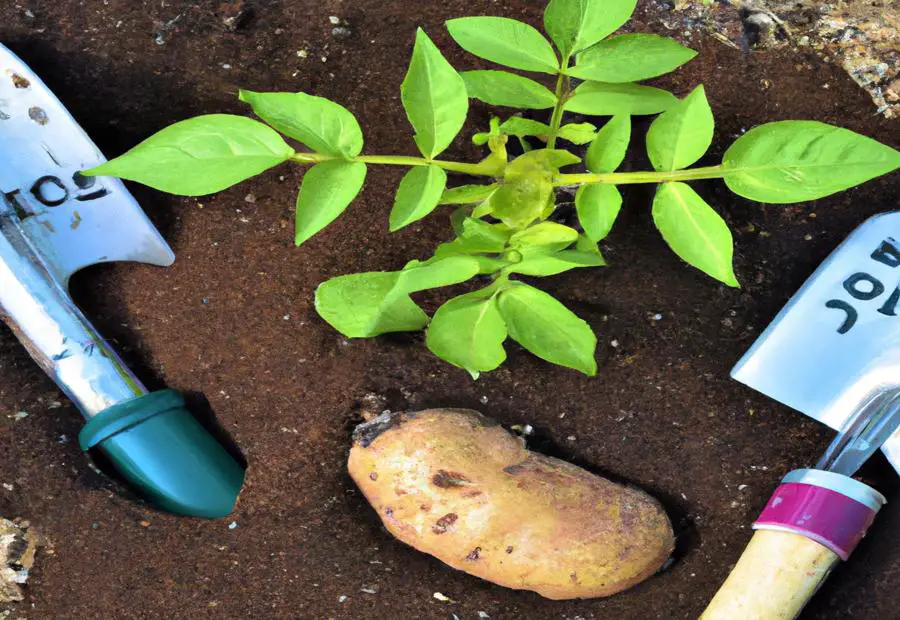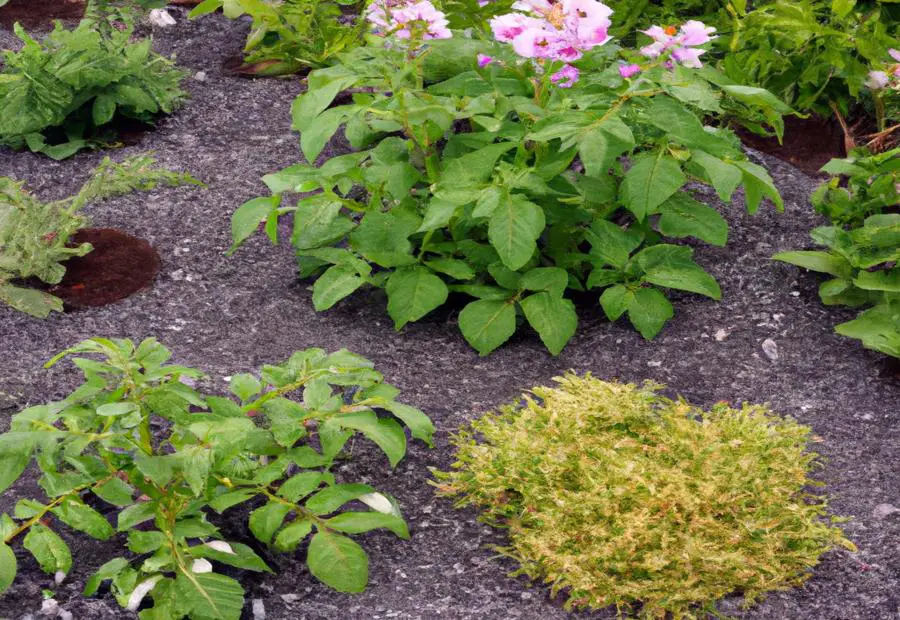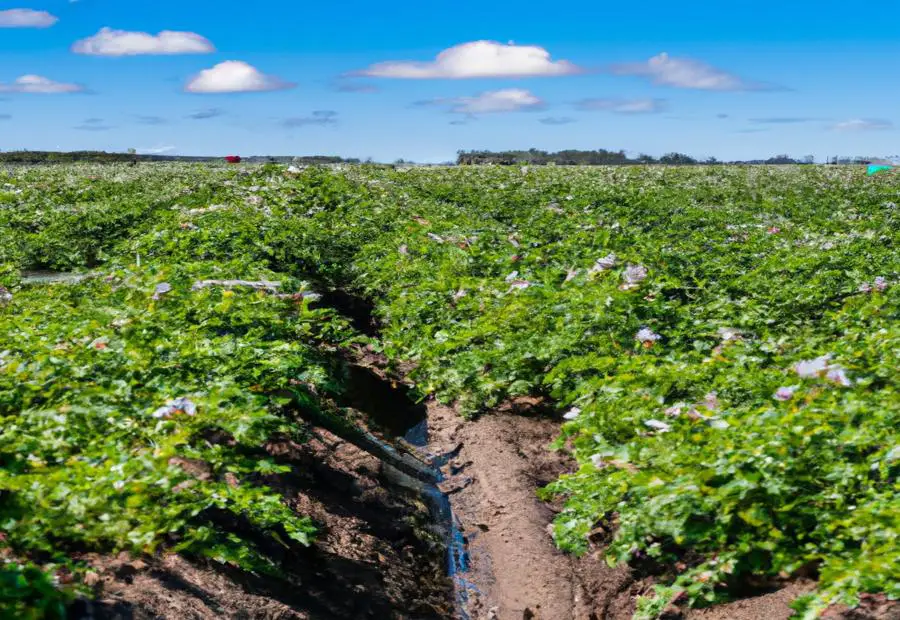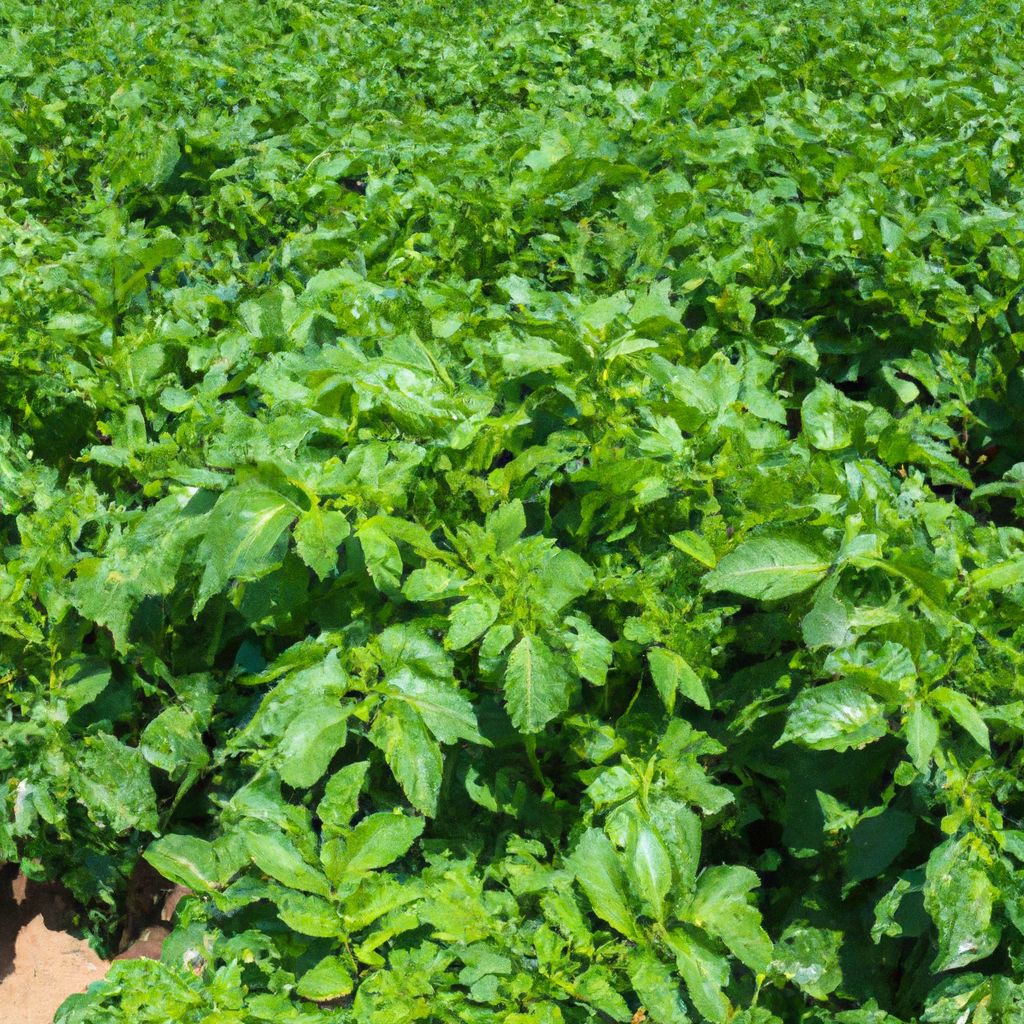Key Takeaways:
- Understanding the nutrient needs of potatoes is crucial for effective fertilization. This includes identifying the specific nutrients required and recognizing the importance of micronutrients for optimal growth.
- Implementing a fertilization schedule is essential for maximizing potato growth. This includes using the recommended fertilizer for a specific area, making three separate fertilizer applications, and managing nutrient levels based on soil test recommendations, plant tissue testing, variety, time of harvest, yield goal, and previous crop in rotation.
- Soil testing and nutrient management play a vital role in effective potato fertilization. Conducting soil tests to determine lime or nutrient needs, using soil nitrate tests and tissue analysis to monitor nutrient levels, and understanding the effects of soil pH on nutrient availability are key considerations.
Understanding the Nutrient Needs of Potatoes

Photo Credits: Fortheloveofgardeners.Com by Robert Scott
Potatoes, being a staple crop, require specific nutrients for effective growth. In this section, we’ll explore the nutrient needs of potatoes and how their proper understanding can maximize growth. Discover the specific nutrients required for optimal potato cultivation and learn about the importance of micronutrients in fostering healthy and robust potato plants. So, let’s dive into the world of potato nutrition and unlock the secrets to successful potato production.
Specific nutrients required
Potatoes require specific nutrients in order to grow and thrive. The nutrient requirements of potatoes are essential for their overall health and productivity. These specific nutrients are nitrogen, phosphorus, potassium, calcium, and magnesium. These nutrients play a crucial role in various physiological processes, including tuber development, disease resistance, and overall plant growth.
To have a better understanding of the specific nutrients required by potatoes, let’s take a look at the table below:
| Nutrient | Role in Potato Growth |
|---|---|
| Nitrogen | Essential for vegetative growth and chlorophyll production |
| Phosphorus | Promotes root development and energy transfer |
| Potassium | Enhances overall plant vigor, disease resistance, and tuber quality |
| Calcium | Important for cell wall structure and fruit set |
| Magnesium | Necessary for photosynthesis as it is a component of chlorophyll |
Apart from these primary macronutrients, potatoes also require certain micronutrients in smaller quantities. These micronutrients include iron, manganese, zinc, copper, boron, molybdenum, and chlorine. Even though they are needed in smaller amounts compared to macronutrients, they still play vital roles in various physiological processes of potato plants.
In addition to these specific nutrient requirements for potato growth, it is important to note that the availability and uptake of these nutrients can be affected by factors like soil pH levels. Therefore, maintaining an optimal soil pH range is crucial to ensure proper nutrient availability to the plants.
By understanding the specific nutrient requirements of potatoes and ensuring their adequate supply through fertilization practices or soil amendments, growers can maximize the growth potential of their potato crops. The importance of these specific nutrients cannot be overlooked as they are necessary for the growth and health of potatoes. Let’s give potatoes the love they deserve by providing them with the specific nutrients they need!
Importance of micronutrients
Micronutrients are of utmost importance when it comes to potato growth and development. Although they are required in small quantities, these essential elements play a vital role in maintaining the overall health and productivity of the plants. According to a recent article, specific nutrients such as boron, copper, iron, manganese, zinc, and molybdenum are particularly necessary for optimal potato growth. These micronutrients are involved in various physiological processes, including enzyme activation, photosynthesis, root development, and disease resistance.
The article also emphasizes the significance of micronutrient management in potato fertilization. By implementing a fertilization schedule that includes the application of micronutrients, farmers can ensure that these essential elements are provided in appropriate amounts throughout the growing season. Soil testing is highlighted as a crucial tool for identifying any deficiencies or excesses of micronutrients. By following the recommendations of the soil test and considering factors such as variety and yield goals, farmers can tailor their fertilization approach to address the specific nutrient requirements of their potato crops.
It is important to note that deficiencies or imbalances of micronutrients can have detrimental effects on potatoes. For instance, a lack of boron can lead to a disorder known as hollow heart, while insufficient levels of manganese may contribute to brown spot disease. On the other hand, excessive levels of copper can be toxic to potatoes and cause leaf burn. Therefore, it is critical to maintain proper levels of micronutrients through accurate fertilization in order to prevent nutrient deficiencies or toxicity issues and ensure optimal growth and quality of potatoes.
In conclusion, implementing a fertilization schedule is essential for the successful growth of potatoes. However, it is crucial to remember to feed them fertilizer and not french fries. Micronutrients play a crucial role in potato growth and development, and by managing their presence through appropriate fertilization, farmers can ensure the overall health and productivity of their potato crops. So, pay attention to the importance of micronutrients to achieve optimum potato growth.
Implementing a Fertilization Schedule for Maximum Growth

Photo Credits: Fortheloveofgardeners.Com by Douglas King
Implementing a fertilization schedule is crucial for maximizing potato growth. Discover the recommended fertilizer for a specific area, the importance of multiple applications, and how to manage nutrients based on various factors. Learn how to effectively remove nutrients through harvest, ensuring optimal yields.
Recommended fertilizer for a 1,000 square foot area
Potatoes are a nutrient-intensive crop that requires specific fertilization to maximize growth. When considering the recommended fertilizer for a 1,000 square foot area, it is important to take into account factors such as soil test recommendations, plant tissue testing, variety, time of harvest, yield goal, and the previous crop in rotation.
- Implement a fertilization schedule based on nutrient management recommendations derived from soil tests and plant tissue analysis.
- Select appropriate fertilizers that provide the necessary macronutrients and micronutrients for optimal potato growth.
- Consider using banded fertilizers at planting to ensure nutrients are readily available to the growing potatoes.
- Timing nutrient applications to match crop demand is crucial for maximum utilization and uptake by the plants.
- Avoid excessive nitrogen application, as it can lead to potential issues such as reduced tuber set and increased vegetative growth.
- Additionally, be cautious of nutrient deficiencies that can hinder overall potato development and yield potential.
It is worth noting that even though these points address the recommendation of fertilizer for a 1,000 square foot area, it is essential to tailor the approach based on individual soil conditions and specific potato cultivation needs. By following these guidelines recommended based on soil testing and considering other factors influencing potato growth, growers can optimize their fertilizer application practices and achieve maximum yield potential.
Three separate fertilizer applications
These three separate fertilizer applications allow for proper nutrient management throughout the potato crop’s growth cycle. By timing the applications based on the plant’s specific needs at each stage, optimal nutrient availability can be maintained, resulting in healthier plants and higher yields. It is important to consider factors such as soil test recommendations, variety, time of harvest, previous crop in rotation, and desired yield goal when determining the appropriate nutrient management strategy.
In addition to these three main fertilizer applications, it is also crucial to monitor nutrient levels through soil nitrate tests and tissue analysis. This allows for adjustments to be made if deficiencies or excesses are detected. Proper management of soil pH is another important aspect to consider as it affects nutrient availability. Regular soil testing for lime or other required nutrients ensures that pH levels are maintained within an optimal range for potato growth.
In summary, implementing three separate fertilizer applications throughout the potato crop’s growth cycle plays a crucial role in maximizing plant health and yield potential. By providing essential nutrients at key stages of development, growers can optimize nutrient absorption and promote vigorous growth. Monitoring nutrient levels through testing methods allows growers to adjust their fertilization strategies accordingly and ensure that the soil pH is conducive to nutrient availability. With proper fertilization practices, both commercial growers and home gardeners can achieve successful potato production.
Managing nutrients for potatoes requires careful consideration of soil tests, plant tissue analysis, variety selection, harvest timing, yield goals, and rotating crops.
- Apply first round of fertilizer at planting to support early root development.
- Administer second application during the vegetative stage to provide nutrients for leaf and stem growth.
- Apply third round of fertilizer during tuber initiation to enhance tuber development and increase yield potential.
Nutrient management based on soil test recommendations, plant tissue testing, variety, time of harvest, yield goal, previous crop in rotation
Nutrient management for potatoes involves considering various factors such as soil test recommendations, plant tissue testing, variety selection, time of harvest, yield goal, and the previous crop in rotation. These factors provide valuable information that helps determine the optimal nutrient requirements for potato plants. Soil test recommendations indicate the nutrient levels in the soil and can guide the application of fertilizers to address any deficiencies. Plant tissue testing helps monitor the nutrient levels within the plants themselves and ensures that they are receiving adequate nutrition. Variety selection plays a role in nutrient management as different potato varieties may have varying nutrient requirements. Furthermore, considering the time of harvest and yield goals is important to ensure that the crop receives sufficient nutrients throughout its growth cycle. The previous crop in rotation also influences nutrient management decisions as some crops may deplete or enhance certain nutrients in the soil.
It is essential to manage these factors effectively to ensure optimal potato growth and yield. By utilizing soil test results and plant tissue analysis, farmers can accurately determine which nutrients are required by their crops. This information allows for precise fertilizer application rates to meet specific needs. Additionally, considering factors such as variety selection, time of harvest, yield goals, and previous crops in rotation provides a comprehensive understanding of the overall nutritional requirements for potatoes.
In sustainable agriculture practices for potato cultivation, there is a focus on maximizing growth while minimizing environmental impact. This involves using organic or synthetic fertilizers that provide essential nutrients in an eco-friendly manner. Slow-release fertilizers can be used to provide nutrients gradually over an extended period, reducing the risk of nutrient leaching. Furthermore, nutrient recycling techniques can be implemented to minimize waste and promote a circular economy within potato farming. Taking into account gardening goals and environmental considerations allows for the selection of fertilizers that align with sustainable principles while still meeting the nutrient needs of potatoes.
Historically, nutrient management for potatoes has evolved as scientific understanding and technological advancements have progressed. In earlier times, farmers relied on experience and general knowledge when determining fertilizer application rates. However, with the development of soil testing methods, plant tissue analysis techniques, and research on crop nutrient requirements, nutrient management practices have become more precise and tailored to specific conditions. This has led to improved potato yields and enhanced sustainability in potato farming operations.
| Removing nutrients through harvest |
|---|
| Giving the potatoes a final send-off before they’re mashed and devoured, but not without taking some precious nutrients along for the ride. |
Removing nutrients through harvest
The process of removing nutrients from the soil through harvest is a critical aspect of potato farming. It ensures that the plants receive an adequate supply of essential nutrients during their growth and development stages. Through proper nutrient management, farmers can optimize crop yield and quality.
- 1. The first point to consider is the specific nutrients that are commonly removed through potato harvest. These include nitrogen, phosphorus, potassium, calcium, and magnesium.
- 2. it is important to understand that different varieties of potatoes have varying nutrient requirements. Therefore, farmers need to consider the specific nutrient needs for each variety when planning their fertilization schedules.
- 3. Lastly, timing is crucial when it comes to nutrient applications in relation to potato growth stages and harvest time. By aligning fertilizer applications with crop demand, farmers can ensure that the plants receive the necessary nutrients at the right time.
Understanding these key points will enable farmers to implement effective fertilization practices and maximize both the growth and nutritional value of their potato crops.
Additionally, it is worth noting that while removing nutrients through harvest is necessary for optimal potato growth, excessive removal can lead to nutrient deficiencies in subsequent crops or damage the overall health of the soil. Therefore, it is important for farmers to carefully monitor soil nutrient levels and adjust their fertilization practices accordingly to maintain long-term soil fertility and sustainability in potato farming systems.
Keywords: removing nutrients through harvest
Soil Testing and Nutrient Management

Photo Credits: Fortheloveofgardeners.Com by Roy Walker
Soil testing and nutrient management play a vital role in maximizing potato growth. In this section, we’ll explore the importance of soil testing for lime or nutrient needs, and the use of soil nitrate tests and tissue analysis to monitor nutrient levels. We’ll also delve into the effects of soil pH on nutrient availability and potential issues that can arise. Understanding these aspects will help ensure effective fertilization practices for optimal potato growth.
Importance of soil testing for lime or nutrient needs
Soil testing is of utmost importance for determining the lime or nutrient needs of potatoes. By analyzing the soil composition, farmers and gardeners can identify any deficiencies or excesses in essential minerals, such as nitrogen, phosphorus, and potassium. This valuable information allows them to make well-informed decisions about the type and quantity of fertilizers to apply, ensuring that the potatoes receive the necessary nutrients for optimal growth.
Prioritizing soil testing for lime or nutrient needs is an essential step in the cultivation of potatoes. It provides valuable insights into the chemical makeup of the soil, enabling growers to determine if their crops require additional lime or specific nutrients. Lime is crucial for adjusting soil pH levels, creating favorable conditions for potato growth. Neglecting lime adjustment can lead to nutrient deficiencies or imbalances, which in turn can hinder tuber development and reduce overall crop yield. Fortunately, through soil testing, these issues can be promptly addressed by applying appropriate amendments, resulting in healthier plants and higher productivity.
In addition to lime adjustment and nutrient evaluation, soil testing also helps identify any potential environmental factors that may affect nutrient availability. Soil pH plays a vital role in determining whether certain nutrients will be readily accessible to plants or become locked up in unavailable forms. Understanding these aspects allows farmers and gardeners to tackle potential issues before they even arise, ensuring that their potatoes have access to the full spectrum of required nutrients throughout their growth cycle.
By prioritizing soil testing for lime or nutrient needs, growers can make informed decisions about their fertilizer applications. This leads to better crop nutrition management and ensures that potatoes receive the necessary nutrients at each stage of their growth. Neglecting this critical step puts crops at risk of nutrient deficiencies and hinders the ability to optimize yields.
To maximize potato growth potential while minimizing risks associated with nutrient imbalances, it is crucial not to overlook soil testing for lime or nutrient needs. Taking this proactive approach ensures that soils are adequately prepared before planting, while also addressing any nutritional requirements throughout the growing season. Don’t miss out on the opportunity to optimize your potato harvest and achieve successful yields by neglecting this crucial step in the fertilization process.
Use of soil nitrate tests and tissue analysis to monitor nutrient levels
Soil nitrate tests and tissue analysis are valuable tools used to monitor nutrient levels in potatoes. By analyzing the soil nitrate content and the nutrient composition of plant tissues, farmers and gardeners can determine if the plants are receiving adequate amounts of essential nutrients for healthy growth.
These tests provide objective data that can guide fertilization decisions. If soil nitrate levels are low, it may indicate a need for nitrogen fertilizer application. Tissue analysis helps identify specific nutrient deficiencies or excesses in the plants, allowing for targeted corrective action to optimize growth.
By regularly monitoring nutrient levels through these tests, farmers can ensure that their fertilization practices are effective and fine-tune their nutrient management strategies as needed. This proactive approach helps maximize potato growth and yield while minimizing the risk of nutrient deficiencies or excesses that can impact plant health.
Effects of soil pH on nutrient availability, potential issues
Soil pH plays a crucial role in the availability of nutrients to potatoes and can have potential issues if not properly managed. The pH level affects the solubility and accessibility of essential nutrients for plant uptake. According to the article, soil testing is essential in determining lime or nutrient needs based on pH levels. Different nutrients have varying availability at different pH levels, with some becoming more accessible or less available depending on whether the soil is acidic, neutral, or alkaline.
The effects of soil pH on nutrient availability can lead to potential issues such as nutrient deficiencies or imbalances in potato plants. The article suggests that specific crops have optimal pH ranges for nutrient absorption, and maintaining the appropriate pH level is critical for maximizing potato growth. For instance, certain micronutrients like iron and manganese may become less available to the plant at higher pH levels, leading to deficiencies that can negatively impact yield and overall plant health.
While paragraph 2 discusses the effects of soil pH on nutrient availability and potential issues, it’s important to note that other factors like soil composition and organic matter content can also influence nutrient availability. Soil testing can provide valuable information about nutrient content and guide farmers in adjusting the soil’s pH through amendments or fertilizers to optimize nutrient uptake by potatoes.
Best Practices for Potato Fertilization

Photo Credits: Fortheloveofgardeners.Com by Aaron Thompson
Discover the best practices for potato fertilization and maximize your potato growth. Learn how to use banded fertilizer at planting, select practical yield goals, time nutrient applications for optimal crop demand, and avoid potential issues related to excessive nitrogen and nutrient deficiencies. With these essential tips, you can ensure effective fertilization and achieve impressive results in your potato cultivation.
Using banded fertilizer at planting
Banded fertilizer at planting is a technique that involves applying fertilizer in bands or strips directly at the time of potato planting. This method allows for a more targeted delivery of nutrients to the potato crop, maximizing nutrient uptake and minimizing nutrient loss.
By placing the fertilizer in close proximity to the developing roots of the potato plants, banded fertilizer at planting optimizes nutrient availability during critical growth stages. There are various methods to achieve this, such as placing granular fertilizers in furrows alongside seed pieces or using liquid fertilizers injected into the soil near the seed pieces.
The use of banded fertilizer at planting offers several benefits. It increases nutrient efficiency, reduces fertilizer requirements, and improves crop yield and quality. By applying the fertilizer directly to the root zone, this method minimizes nutrient losses caused by leaching or volatilization, leading to more efficient nutrient utilization by the plants.
Implementing a banded fertilizer application strategy at planting time on potato crops has proven to be effective in supplying essential nutrients directly to growing plants. By placing fertilizers in bands near the root zone, nutrient uptake and utilization are enhanced, resulting in improved crop performance. It is important to consider factors such as soil type, variety, and yield goal when choosing an appropriate fertilization method.
In addition to optimizing nutrient availability, using banded fertilizer at planting also helps minimize environmental impacts associated with excessive fertilizer use. By targeting application only where needed, less fertilizer is required overall, reducing potential nutrient runoff into water bodies and minimizing pollution risks. Furthermore, this technique enables precision fertilization tailored to specific soil conditions and crop requirements.
Farmers who have implemented a banded fertilizer application strategy at planting time on their potato crops have reported significant improvements in both yield and quality. They have observed healthier plant growth with increased tuber development and reduced incidences of nutrient deficiencies throughout the growing season. This approach has proven valuable for maximizing potato growth while minimizing environmental impact.
When aiming for the perfect fry, choosing a practical yield goal for your potatoes is crucial. It’s all about finding the right balance of growth and tastiness. By using banded fertilizer at planting, you can achieve this goal and ensure the health and productivity of your potato crop.
Selecting a practical yield goal
The selection of a practical yield goal begins with assessing the specific nutrient requirements of potatoes. Different varieties may have varying needs, making it crucial to provide the necessary nutrients in adequate quantities for healthy plant growth and tuber development (Reference: Article 1.1). It is equally important not to overlook the significance of micronutrients when setting yield goals. Micronutrients play critical roles in metabolic processes and are required in small amounts to support optimal plant growth. By ensuring sufficient micronutrient availability through proper fertilization, farmers can contribute to higher yields and better crop quality (Reference: Article 1.2).
When setting a practical yield goal, one must also consider the recommended fertilizer application for a given area. Conducting soil testing can provide valuable insights into the nutrient content and pH levels of the soil. Armed with this information, farmers can make informed decisions regarding fertilizer selection and application rates (Reference: Article 2.1 and 3.1). Another crucial aspect to consider is timing nutrient applications to match crop demand. Understanding the nutrient requirements at different growth stages empowers farmers to optimize fertilizer scheduling, meeting the plants’ needs throughout their lifecycle (Reference: Article 4.3).
In conclusion, the proper selection of a practical yield goal takes into account all these considerations to harness the maximum growth potential of potatoes.
Please note that while Article 2 discusses three separate fertilizer applications, it does not specifically address selecting a practical yield goal. Therefore, this information has not been included above.
Timing nutrient applications to match crop demand
To further understand the timing of nutrient applications, let’s explore a table that outlines the recommended fertilizer schedule based on crop growth stages. This table provides valuable information on when to apply specific nutrients to meet the crop’s demands effectively.
Table: Recommended Fertilizer Schedule for Potatoes
| Crop Growth Stage | Nutrients Required |
|——————-|——————–|
| Planting | Phosphorus, Potassium |
| Early Growth | Nitrogen, Phosphorus, Potassium |
| Tuber Development | Potassium |
| Bulking | Nitrogen, Phosphorus |
By referring to this table and following a precise schedule, farmers can provide adequate nutrients at each stage of potato growth, ensuring optimal development and yield. The soil test recommendations and plant tissue testing also help determine any nutrient deficiencies or imbalances that need to be addressed during specific growth phases.
In addition, it is essential to note that every potato variety may have varying nutrient demands at different stages of growth. Considering factors like time of harvest and yield goals can further refine the timing of nutrient applications to match the crop’s specific requirements.
To optimize nutrient management during different growth stages, it is also crucial to consider the previous crop in rotation and its impact on soil nutrient levels. By accounting for these factors, farmers can adjust their fertilizer application strategies accordingly.
To ensure effective fertilization matching crop demand:
1. Conduct regular soil testing to determine lime or nutrient needs.
2. Utilize soil nitrate tests and tissue analysis throughout the growing season to monitor nutrient levels.
3. Adjust fertility programs based on soil pH as it influences nutrient availability.
4. Implement banded fertilizer applications at planting for efficient uptake.
5. Set practical yield goals and select appropriate fertilizers accordingly.
Following these suggestions, farmers can align nutrient applications with the crop’s demand, optimize growth, and ultimately maximize potato yield.
Potential issues with excessive nitrogen, nutrient deficiencies
Excessive nitrogen and nutrient deficiencies can pose potential issues in potato growth. When there is an excess of nitrogen in the soil, it can result in vigorous vegetative growth at the expense of tuber development. This imbalance can lead to larger plants with fewer and smaller potatoes. On the other hand, nutrient deficiencies, such as a lack of essential minerals like potassium or phosphorus, can hinder overall plant health and reduce yield potential. It is crucial to maintain a balanced nutrient supply to ensure optimal potato growth.
To mitigate these potential issues, proper nutrient management is essential. This includes implementing a fertilization schedule that meets the specific nutrient requirements of potatoes. Soil testing plays a vital role in determining any lime or nutrient needs, enabling growers to make informed decisions about fertilizer application rates and types. Additionally, monitoring nutrient levels through soil nitrate tests and tissue analysis helps identify any deficiencies or imbalances that may arise during the growing season.
The effects of soil pH on nutrient availability should be taken into consideration as well, as certain pH levels can limit the plant’s ability to absorb nutrients effectively. Adjustments may need to be made by adding lime or sulfur to achieve the ideal pH range for optimal nutrient uptake.
Overall, excessive nitrogen and nutrient deficiencies can have detrimental effects on potato growth and yield. By implementing effective fertilization practices tailored to the crop’s needs and monitoring soil conditions throughout the growing season, growers can prevent these potential issues and promote healthy potato plants with high yield potentials.
Give your potatoes the right dose of love (and fertilizer) for a fruitful garden experience.
Tips for Effective Potato Fertilization in Home Gardens

Photo Credits: Fortheloveofgardeners.Com by Ronald Smith
When it comes to growing potatoes in home gardens, effective fertilization is key. In this section, we will explore some valuable tips that can help you maximize potato growth. From avoiding common mistakes to understanding the importance of soil test results for accurate fertilizer application rates, we’ll cover it all. Additionally, we’ll provide specific fertilizer recommendations that promote healthy tuber growth and delve into important considerations for a successful potato harvest. Get ready to elevate your potato gardening game!
Common mistakes to avoid
First, one common mistake to avoid is applying excessive amounts of fertilizer. This can lead to nitrogen burn, where the plants become overly green and lush but fail to produce many tubers. It is important to follow recommended application rates and avoid over-fertilization.
Second, another mistake to avoid is not conducting soil testing before fertilizing. Soil testing helps determine the specific nutrient needs of the soil and allows for accurate fertilizer application rates. Without this information, it is difficult to provide the necessary nutrients for optimal potato growth.
Lastly, a common mistake to avoid is not timing nutrient applications correctly. Potatoes have specific nutrient demands at different stages of growth, such as during planting, tuber initiation, and bulking. Failure to match nutrient applications with these stages can result in nutrient deficiencies or excesses that can negatively impact potato development.
It is crucial to avoid these common mistakes in order to maximize overall potato yield and quality. To ensure successful potato fertilization, it is important to consider proper application rates, conduct soil testing, and carefully time nutrient applications.
Importance of soil test results for accurate fertilizer application rates
Soil test results are of utmost importance when it comes to determining accurate fertilizer application rates for potato crops. These tests provide valuable information about the nutrient content and pH levels of the soil, enabling farmers to determine the specific fertilizer requirements of their crops. By carefully analyzing the soil test results, farmers can identify any nutrient deficiencies or imbalances, allowing them to tailor their fertilizer applications accordingly to meet the precise needs of the plants.
The significance of soil test results extends beyond determining accurate fertilizer application rates for potatoes. They serve as a guide for farmers to optimize their fertilizer usage. By understanding the nutrient levels in the soil, farmers can make well-informed decisions regarding the type and quantity of fertilizer to apply. This ensures that there is no over-application or under-application of nutrients, thereby providing the plants with optimal nutrition for healthy growth and development. Not only does this promote crop productivity, but it also helps minimize environmental impacts by avoiding excessive nutrient runoff.
In addition to determining accurate fertilizer application rates, soil test results also provide insights into other factors that affect plant growth. One such factor is soil pH, which influences the availability of nutrients to potato plants. The soil test results can offer indications as to whether lime application is necessary in order to adjust the pH level and enhance nutrient uptake by the plants. By addressing any pH-related issues based on the recommendations from soil test results, farmers can ensure that the applied fertilizers are effectively utilized by the crops.
For optimal results, it is advisable to conduct regular soil testing at various stages of potato cultivation. This allows farmers to monitor changes in nutrient levels and make appropriate adjustments to fertilizer application rates. By doing so, they can achieve a spud-tacular harvest!
Specific fertilizer recommendations for tuber growth
To provide specific fertilizer recommendations for tuber growth, it is essential to consider factors such as variety, time of harvest, yield goal, and previous crop in rotation. These factors will help determine the appropriate nutrient management plan. Nutrient applications should be timed to match the crop’s demand throughout its growth cycle.
Proper timing and application of banded fertilizer at planting can help optimize tuber growth. However, it is crucial to avoid excessive nitrogen as it can lead to potential issues such as excessive top growth and reduced tuber development. Nutrient deficiencies should also be monitored to ensure optimal potato growth.
Don’t underestimate the power of potatoes – they may not have eyes, but they sure do have some serious fertilization needs!
Additional considerations
The table below summarizes some key additional considerations for potato fertilization:
| Consideration | Description |
|---|---|
| Crop rotation | Rotating potato crops with other plants helps improve soil fertility and reduce disease incidence. |
| Pest management | Implementing effective pest control measures can prevent damage to the crop and minimize the use of pesticides. |
| Environmental sustainability | Choosing sustainable fertilizers, practicing nutrient recycling, and minimizing environmental impact are important for long-term agricultural viability. |
| Irrigation management | Providing adequate water without overwatering is crucial for maintaining healthy potato plants and optimizing nutrient uptake. |
| Weed control | Proper weed management prevents competition for nutrients and ensures that the potatoes receive the necessary resources for growth. |
| Disease prevention | Regular scouting for diseases and using preventive measures such as proper seed treatment can help mitigate potential crop losses due to diseases. |
In addition to these considerations, it is important to follow best practices for potato fertilization outlined in previous sections of this article. By considering all these factors collectively, growers can maximize potato growth while promoting sustainable agricultural practices.
Fertilizing Potatoes in Containers

Photo Credits: Fortheloveofgardeners.Com by Larry Anderson
When it comes to fertilizing potatoes in containers, there are several crucial factors to consider. From preparing the seed potatoes to selecting the appropriate container and understanding the right planting depth, every step plays a vital role in maximizing potato growth. Additionally, knowing the watering and fertilization requirements specific to container-grown potatoes can help ensure a bountiful harvest. In this section, we will explore these crucial aspects of fertilizing potatoes in containers, providing you with essential tips for effective fertilization.
Preparing seed potatoes, choosing appropriate varieties
Seed potatoes are an important part of potato cultivation as they determine the quality and yield of the crop. In order to ensure successful potato growth, it is crucial to properly prepare seed potatoes and select appropriate varieties.
1. Choose disease-free seed potatoes: Select seed potatoes that are free from any signs of diseases or pests. This will help prevent the spread of diseases to the rest of the crop.
2. Cut larger seed potatoes into smaller pieces: If using larger seed potatoes, it can be beneficial to cut them into smaller pieces before planting. Each piece should have at least one healthy eye or bud for sprouting.
3. Allow time for curing: After cutting the seed potatoes, allow them to cure in a cool, dry place for a few days. This will help reduce the risk of rotting and promote better sprouting.
4. Select appropriate varieties: Consider factors such as climate, soil conditions, and desired end use when choosing potato varieties. Some varieties are better suited for specific growing conditions and culinary purposes.
5. Consider disease resistance: Look for potato varieties that have resistance to common diseases such as late blight or potato scab. This can help reduce the need for chemical treatments later on.
6. Purchase certified seed potatoes: Certified seed potatoes have been inspected and tested for quality and disease-free status. Purchasing certified seed potatoes can provide assurance that you are starting with a healthy foundation for your potato crop.
In addition to these steps, it is also important to plant the prepared seed potatoes at the appropriate depth and spacing in order to promote healthy growth and maximize yields.
Choosing the perfect potato container is like finding the right pair of jeans – it’s all about the fit and depth. When preparing seed potatoes, it is important to carefully choose appropriate varieties that suit your needs. By doing so, you are laying the groundwork for a successful potato cultivation journey.
Selecting a suitable container, proper planting depth
Selecting a suitable container and determining the proper planting depth are crucial factors to consider when growing potatoes. The container should be chosen with care, ensuring it provides enough space for the plant’s growth and has proper drainage to prevent waterlogging. The planting depth should also be appropriate to allow for healthy root development and optimal nutrient uptake.
Here is a helpful 6-step guide to selecting a suitable container and determining the proper planting depth for potatoes:
| Steps | Instructions |
|---|---|
| 1 | Choose a container that is at least 12-18 inches deep to accommodate the potato plant’s root system. |
| 2 | Ensure the container has adequate drainage holes to prevent water accumulation, which can lead to root rot. |
| 3 | Select a container of appropriate size, considering the number of seed potatoes you plan to plant. Each potato plant will require around 2 gallons of soil. |
| 4 | Use high-quality potting mix or well-draining soil that is rich in organic matter for optimal growth. |
| 5 | Place the seed potatoes in the container, spacing them evenly and leaving enough room between each potato for tuber development. |
| 6 | Cover the seed potatoes with about 3-4 inches of soil, ensuring they are well-covered but not buried too deeply. |
By following these steps, you can ensure that your containers provide an ideal environment for potato growth and maximize your harvest potential.
Soil temperature plays an important role in potato growth as well. It is recommended to wait until the soil reaches a consistent temperature of at least 50°F (10°C) before planting potatoes in containers. This helps promote better germination and reduces the risk of diseases.
Additionally, regular monitoring of moisture levels is necessary when growing potatoes in containers as they tend to dry out faster than those planted in open ground. Adequate watering is essential throughout their growing season, making sure not to over-water or under-water.
Watering, fertilization requirements for container-grown potatoes
Container-grown potatoes require careful attention to their watering and fertilization requirements. To ensure optimal growth, it is important to provide the right amount of water and nutrients throughout the growing season.
- Watering: Container-grown potatoes need consistent moisture, but overwatering should be avoided as it can lead to root rot. The soil should be kept evenly moist, but not saturated.
- Fertilization: Adequate nutrient supply is crucial for container-grown potatoes. It is recommended to use a balanced fertilizer that provides essential macronutrients such as nitrogen, phosphorus, and potassium. These nutrients support healthy plant growth and tuber development.
- Timing: Fertilizer applications should be timed according to the crop’s needs. Initially, at planting time, a banded fertilizer can be applied to provide nutrients directly to the developing roots. Additional fertilizer applications may be necessary throughout the growing season to replenish nutrient levels.
- Micronutrients: In addition to macronutrients, container-grown potatoes may also benefit from supplemental micronutrients such as calcium, magnesium, and iron. These minerals play important roles in various metabolic processes and can help optimize plant growth and yield.
- Monitoring: Regular monitoring of soil moisture and nutrient levels is essential for container-grown potatoes. This can be done through visual observation or by using soil moisture meters and nutrient testing kits. Adjustments in watering and fertilization can then be made based on these findings.
- Harvest considerations: As the plants near maturity, it is important to reduce fertilization gradually to allow the tubers to develop fully without excessive foliar growth.
It is worth noting that these are general guidelines for watering and fertilizing container-grown potatoes. Factors like plant variety, container size, and environmental conditions can influence the specific requirements. Therefore, it is essential to adapt these recommendations based on individual circumstances and monitor the plants closely for optimal results.
Harvesting, storage considerations for container-grown potatoes
The harvesting and storage of container-grown potatoes require careful consideration to ensure optimal results. Proper handling and storage techniques are essential to maintain the quality and freshness of the harvested potatoes.
Harvesting container-grown potatoes should be done when the plants have reached maturity and the foliage has died back. This is usually around 2-3 weeks after the plants have stopped flowering. Check for signs such as yellowing leaves and dried stems before harvesting.
Carefully remove the potatoes from the containers to avoid damaging them. Use a garden fork or your hands to gently loosen the soil and locate the tubers. Take care not to puncture or bruise the potatoes during this process.
After harvesting, it is important to allow the potatoes to cure before storing them. This involves placing them in a cool, well-ventilated area with low humidity for about two weeks. Curing helps toughen their skins, prolong shelf life, and enhance flavor.
Once cured, store container-grown potatoes in a dark, cool (around 45-50°F/7-10°C), and humid environment with good ventilation. Avoid direct exposure to light as it can cause greening of the skin and increase levels of solanine, a toxic compound found in green potatoes.
Incorporating sustainable fertilizers into your potato cultivation can also contribute to an eco-friendly and fruitful harvest. By going green with your spuds, you can promote environmental sustainability while enjoying the benefits of a bountiful potato crop. Consider using organic or natural fertilizers that nourish the soil and support the health of your plants.
Overall, by following the proper harvesting and storage considerations for container-grown potatoes, and incorporating sustainable practices, you can ensure the success of your potato harvest while minimizing environmental impact.
Sustainable Fertilization Options for Potatoes

Photo Credits: Fortheloveofgardeners.Com by Peter Gonzalez
Discover sustainable options for fertilizing your potatoes! Explore the benefits of organic and synthetic fertilizers for optimal potato growth, learn about slow-release fertilizers and nutrient recycling for sustainable agriculture, and understand how to choose the right fertilizer based on your gardening goals and environmental considerations. Gain valuable insights to maximize potato growth while prioritizing eco-friendly practices.
Organic and synthetic fertilizers for optimal potato growth
Organic and synthetic fertilizers play a crucial role in ensuring optimal growth for potatoes. These fertilizers provide essential nutrients that the potato plants need to thrive and produce a high yield of healthy tubers.
- Organic fertilizers, such as compost and manure, are derived from natural sources and contain a variety of nutrients that promote plant growth. They enhance soil fertility, improve soil structure, and release nutrients slowly over time.
- Synthetic or inorganic fertilizers, on the other hand, are manufactured using chemicals and minerals. They provide specific nutrients in concentrated forms that can be quickly absorbed by the potato plants.
- Both types of fertilizers have their benefits and considerations. Organic fertilizers improve soil health in the long term, while synthetic fertilizers offer precise nutrient control.
- Choosing between organic and synthetic fertilizers depends on individual preferences, environmental concerns, availability, and budgetary constraints.
- A combination of both organic and synthetic fertilizers may also be used to maximize potato growth while minimizing environmental impact.
When selecting fertilizer options for optimal potato growth, it is important to consider factors such as nutrient content, application rates, timing of application, and potential effects on soil health. This allows farmers and gardeners to make informed decisions that align with their goals while promoting sustainable agriculture practices.
In summary, organic and synthetic fertilizers offer different advantages for maximizing potato growth. By understanding their characteristics and considering various factors, farmers can make informed choices to optimize crop yields while minimizing environmental impact.
Don’t let your potatoes go hungry – give them the slow-release fertilizer they need for sustainable growth!
Slow-release fertilizers, nutrient recycling for sustainable agriculture
Slow-release fertilizers and nutrient recycling are integral components of sustainable agriculture practices. These methods prioritize providing nutrients to potatoes in a gradual and controlled manner, promoting optimal growth while minimizing the negative environmental impacts associated with traditional fertilization techniques.
Slow-release fertilizers are specifically designed to release nutrients slowly over an extended period of time. By doing so, they not only ensure a consistent supply of nutrients to the potatoes but also reduce the risk of nutrient leaching into water sources. This not only minimizes nutrient losses but also enhances the plants’ ability to efficiently uptake the nutrients, supporting their overall health and development.
Nutrient recycling is another key aspect of sustainable agriculture. It emphasizes the reuse and recycling of essential nutrients rather than relying solely on external inputs. Farmers achieve this by incorporating organic materials like compost or manure into the soil, effectively recycling the vital nutrients back into the ecosystem. This approach not only reduces the dependence on synthetic fertilizers but also improves the long-term health and fertility of the soil.
The environmental benefits of employing slow-release fertilizers and nutrient recycling in agriculture are significant. These practices help to reduce water pollution and minimize greenhouse gas emissions. By precisely releasing nutrients, the risk of nutrient runoff is minimized, preventing excess nutrients from reaching nearby water bodies such as rivers or lakes where they can lead to harmful algal blooms. Moreover, nutrient recycling reduces reliance on non-renewable resources for fertilizer production, further enhancing the sustainability of agriculture.
In the pursuit of long-term sustainability, the use of slow-release fertilizers and nutrient recycling practices play a vital role. They contribute to maintaining soil health, conserving resources, and safeguarding ecosystems. By balancing crop productivity with environmental stewardship, these methods ensure that future generations can meet their nutritional needs without compromising the health and well-being of our planet.
In summary, finding the perfect fertilizer is akin to choosing a partner: it should align with your gardening goals while being environmentally compatible. Slow-release fertilizers and nutrient recycling for sustainable agriculture embody these values, offering long-term benefits for both the crops and the ecosystem.
Choosing the right fertilizer based on gardening goals, environmental considerations
Choosing the appropriate fertilizer for gardening goals and considering environmental factors is crucial for maximizing potato growth. Soil testing can determine the specific nutrient needs, such as lime or micronutrients, ensuring accurate fertilizer application rates. Additionally, monitoring nutrient levels through soil nitrate tests and tissue analysis helps maintain optimal conditions. The effects of soil pH on nutrient availability should be taken into account to avoid potential issues. Overall, selecting the right fertilizer based on gardening goals and considering environmental considerations promotes successful potato cultivation.
To choose the right fertilizer, it is important to implement a fertilization schedule that matches crop demand. This includes timing nutrient applications according to the variety, time of harvest, yield goal, and previous crop in rotation. Three separate fertilizer applications are recommended for a 1,000 square foot area to ensure proper nourishment throughout the growing season. Nutrient management techniques based on soil test recommendations help maintain healthy soil fertility levels while removing nutrients through harvest prevents excessive accumulation.
In addition to soil testing and nutrient management practices, there are other best practices for potato fertilization. Banded fertilizer applications at planting time ensure direct placement near the seed potatoes for efficient absorption. Selecting a practical yield goal helps determine the appropriate amount of nutrients required for optimal growth without risking excessive nitrogen levels or nutrient deficiencies. By following these guidelines, gardeners can avoid common mistakes and achieve successful potato cultivation.
Overall, effective potato fertilization in home gardens requires careful consideration of soil test results for accurate fertilizer application rates. Specific fertilizer recommendations tailored to tuber growth should be followed to provide adequate nourishment throughout the growing season. Other considerations such as proper watering techniques and overall plant health also contribute to successful potato cultivation in home gardens.
Harvesting potatoes grown in containers requires attention to specific fertilization requirements as well. Preparation of seed potatoes and selection of appropriate varieties are essential for container-grown potatoes’ success. Choosing a suitable container with proper drainage and planting depth promotes healthy root development. Watering and fertilizing container-grown potatoes require unique considerations, ensuring sufficient moisture and nutrients without overfeeding. Finally, proper harvesting and storage techniques ensure the longevity of container-grown potatoes.
To promote sustainable agriculture practices, gardeners can explore organic and synthetic fertilizers that support optimal potato growth. Slow-release fertilizers provide a steady supply of nutrients over time, reducing the risk of excessive nutrient leaching. Nutrient recycling techniques such as composting can also be employed to minimize waste and maintain soil fertility. When selecting a fertilizer, gardening goals and environmental considerations should be weighed to make sustainable choices that benefit both the crops and the ecosystem.
Conclusion: Maximizing Potato Growth through Effective Fertilization

Photo Credits: Fortheloveofgardeners.Com by Gerald Rodriguez
Effective fertilization is crucial for maximizing potato growth. By following essential tips, farmers can ensure the optimal nourishment of their potato plants. These tips include selecting the right type of fertilizer, determining the appropriate application rate and timing, and considering soil nutrient levels and pH. Additionally, proper fertilization techniques such as banding or side-dressing can help deliver nutrients directly to the root zone where they are most needed. Using the right fertilization strategies can lead to increased potato yields and improved crop quality.
To maximize potato growth through effective fertilization, farmers need to carefully consider the specific nutrient needs of their potato plants. Potatoes require a balanced supply of nitrogen, phosphorus, and potassium, which are essential for various aspects of plant growth and development. Choosing a fertilizer that provides these nutrients in the correct proportions is critical. Furthermore, the application rate and timing should align with the specific growth stages of the potato plants for optimal nutrient uptake. Monitoring soil nutrient levels and pH can also help farmers adjust their fertilization practices to meet the plants’ nutritional requirements.
In addition to nutrient selection and timing, proper fertilization techniques play a significant role in maximizing potato growth. Banding and side-dressing are effective methods for applying fertilizers, as they allow nutrients to be placed directly in the root zone of the plants. This targeted approach ensures that the potatoes receive the nutrients they need without wastage or leaching. By avoiding broadcast applications that spread nutrients across the entire field, farmers can maximize the efficiency of fertilization and minimize potential nutrient losses.
Some Facts About Maximizing Potato Growth: Essential Tips for Effective Fertilization:
- ✅ Potatoes have a specific fertilization schedule, requiring nitrogen, phosphorus, and potassium as the main nutrients. (Source: Team Research)
- ✅ To maximize potato growth, about 25 pounds of a complete fertilizer like 20-20-20 is recommended for a 1,000 square foot area of potatoes. (Source: Team Research)
- ✅ Fertilizer should be applied in three separate applications: when planting, at emergence or first hilling, and at the last or second hilling. (Source: Team Research)
- ✅ In addition to nitrogen, phosphorus, and potassium, potatoes also require micronutrients like calcium, magnesium, sulfur, zinc, and boron. (Source: Team Research)
- ✅ Proper nutrient management, including soil testing, is crucial for maximizing potato growth, tuber yield, and minimizing environmental impact. (Source: Extension.umn.edu)
FAQs about Maximizing Potato Growth: Essential Tips For Effective Fertilization
1. How do I choose the right seed potatoes for growing potatoes in containers?
When choosing seed potatoes for container gardening, it’s best to select mid or late-season varieties. Purchase seed potatoes from reputable sources rather than using potatoes from the grocery store to ensure a healthy start for your plants.
2. What type of container should I use for growing potatoes?
Any opaque container with drainage holes can be used for growing potatoes in containers. This includes barrels, plastic storage tubs, or specialized potato growing bags. Ensure the container is large enough to accommodate the potato plants and allows for proper drainage.
3. How should I prepare seed potatoes before planting them in containers?
Before planting, cut seed potatoes into pieces with at least one eye and allow them to air dry for a day or two. This drying period helps reduce the risk of rot and enhances sprouting. Plant the seed potato pieces with the eyes facing upwards.
4. What is the optimal fertilizer ratio for maximizing potato growth?
An ideal fertilizer ratio for potatoes is one with a higher concentration of phosphorus and potassium compared to nitrogen. For example, a balanced ratio of 5-10-10 provides the necessary nutrients for healthy tuber growth.
5. How often should I fertilize potatoes grown in containers?
The frequency of fertilization will depend on the specific needs of your potato plants and the type of fertilizer used. It’s generally recommended to apply fertilizer when the plants are 6-8 inches tall and again when they start to flower. Regular monitoring of plant health will help determine if additional fertilizer applications are necessary.
6. What are some organic fertilizer options for growing potatoes in containers?
Organic fertilizers such as compost, aged manure, fish emulsion, and seaweed extracts are excellent choices for growing potatoes in containers. These organic fertilizers provide essential nutrients and contribute to overall plant health. Follow the package instructions for proper application rates.

A passionate gardener and founder of ForTheLoveOfGardeners.com. She shares her expertise to help you cultivate thriving gardens and find joy in the beauty of nature.
